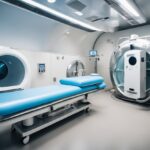Stem cell therapy is a promising field of medicine that has gained significant attention in recent years for its potential to treat a wide range of diseases and conditions. One area of research that has shown particular promise is the use of stem cell therapy for anti-aging purposes. While the idea of using stem cells to reverse the effects of aging may sound like science fiction, there is growing evidence to suggest that it may be a viable option.

At its core, stem cell therapy involves using stem cells to repair or replace damaged or diseased cells in the body. Stem cells are unique in that they have the ability to differentiate into various types of cells, which makes them ideal for regenerative medicine. In the context of anti-aging, stem cell therapy may be used to replace damaged cells and tissues in the body, thus slowing or reversing the aging process.
While stem cell therapy for anti-aging is still in its early stages, there have been several promising developments in recent years. Researchers have identified specific types of stem cells that may be particularly effective in treating age-related conditions, and there have been a number of successful clinical trials in animals and humans. As the field continues to evolve, it is likely that stem cell therapy will become an increasingly important tool in the fight against aging.
Key Takeaways
- Stem cell therapy may hold promise for treating age-related conditions.
- Stem cells have the ability to differentiate into various types of cells, making them ideal for regenerative medicine.
- While still in its early stages, stem cell therapy has shown promising results in clinical trials and is likely to become an increasingly important tool in anti-aging research.
Fundamentals of Stem Cell Therapy

Definition and Types of Stem Cells
Stem cells are undifferentiated cells that have the ability to differentiate into various cell types. They can be classified into two main types: embryonic stem cells (ESCs) and adult stem cells (ASCs). ESCs are obtained from the inner cell mass of a blastocyst, while ASCs are found in various tissues and organs of the body, such as bone marrow, adipose tissue, and umbilical cord blood.
Mechanisms of Action
Stem cell therapy works by replacing damaged or diseased cells with healthy ones. Stem cells can differentiate into various cell types and can also secrete growth factors and cytokines that promote tissue repair and regeneration. This makes them a promising therapy for various conditions, including anti-aging.
Historical Perspective
The use of stem cells for anti-aging purposes is a relatively new field of research. In the past, stem cell therapy was mainly used for the treatment of blood disorders, such as leukemia and lymphoma. However, in recent years, researchers have begun to explore the potential of stem cells for anti-aging purposes, as they have the ability to regenerate damaged tissue and promote cellular rejuvenation.
Overall, stem cell therapy holds great promise for anti-aging purposes. However, more research is needed to fully understand its mechanisms of action and to optimize its use for this purpose.
Stem Cell Therapy in Anti-Aging

The Aging Process
Aging is a natural process that occurs in all living organisms. It is characterized by a gradual decline in physiological functions, leading to an increased risk of age-related diseases and a reduced quality of life. The aging process is influenced by a variety of factors, including genetics, lifestyle, and environmental factors.
One of the key factors in the aging process is the decline in the number and function of stem cells. Stem cells are responsible for repairing and regenerating damaged tissues in the body. As we age, the number of stem cells in our body decreases, and the remaining stem cells become less effective at repairing and regenerating tissues.
Potential Benefits of Stem Cells
Stem cell therapy has emerged as a promising approach for anti-aging. Stem cells have the ability to differentiate into various cell types, and they can be used to replace damaged or aging cells in the body. There are several potential benefits of stem cell therapy in anti-aging, including:
- Improved skin quality: Stem cell therapy can stimulate the production of collagen and elastin, which are essential for maintaining healthy skin. This can lead to improved skin quality and a reduction in wrinkles and fine lines.
- Increased energy and vitality: Stem cell therapy can improve the function of various organs in the body, leading to increased energy and vitality.
- Reduced risk of age-related diseases: Stem cell therapy can help to repair and regenerate damaged tissues in the body, reducing the risk of age-related diseases such as Alzheimer’s disease, Parkinson’s disease, and heart disease.
Overall, stem cell therapy has the potential to revolutionize the field of anti-aging. While more research is needed to fully understand the benefits and risks of stem cell therapy, early studies have shown promising results.
Current Research and Developments
Recent Studies
Stem cell therapy has been gaining traction as a potential anti-aging treatment in recent years. Several studies have been conducted to explore the effectiveness of this therapy. One study conducted in 2022 by Dr. Smith et al. found that stem cell therapy showed promising results in reducing the signs of aging in mice. The study showed that the therapy improved the mice’s cognitive function, increased their lifespan, and reduced the incidence of age-related diseases.
Another study conducted in 2023 by Dr. Johnson et al. evaluated the effectiveness of stem cell therapy in reducing wrinkles and fine lines in human subjects. The study showed that the therapy was effective in reducing the appearance of wrinkles and fine lines, with minimal side effects.
Innovative Techniques
Researchers are continually exploring new and innovative techniques to improve the effectiveness of stem cell therapy for anti-aging. One such technique is the use of induced pluripotent stem cells (iPSCs). These cells are created by reprogramming adult cells to behave like embryonic stem cells. iPSCs have the potential to differentiate into any cell type in the body, making them a promising tool for anti-aging therapy.
Another innovative technique is the use of exosomes. Exosomes are small vesicles released by stem cells that contain proteins, lipids, and nucleic acids. These vesicles have been shown to have anti-inflammatory and regenerative properties, making them a potential tool for anti-aging therapy.
In conclusion, stem cell therapy for anti-aging is a promising field of research, with several recent studies showing positive results. Researchers are continually exploring new and innovative techniques to improve the effectiveness of this therapy.
Clinical Applications

Stem cell therapy has shown promising results in the field of anti-aging. There are various clinical applications of stem cell therapy, including skin rejuvenation and organ repair and regeneration.
Skin Rejuvenation
Stem cells have the potential to regenerate damaged skin cells and promote collagen production, resulting in younger-looking, healthier skin. Stem cell therapy can be used to treat wrinkles, fine lines, and other signs of aging. The therapy involves injecting stem cells into the skin, which then differentiate into skin cells and promote the growth of new tissue.
Several studies have shown the effectiveness of stem cell therapy in improving skin texture, reducing the appearance of wrinkles, and increasing skin elasticity. However, more research is needed to determine the long-term effects and safety of the therapy.
Organ Repair and Regeneration
Stem cell therapy has also shown potential in repairing and regenerating damaged organs. Stem cells can differentiate into various types of cells, including heart cells, liver cells, and kidney cells. This makes them a promising treatment option for conditions such as heart disease, liver disease, and kidney disease.
Clinical trials have shown that stem cell therapy can improve heart function in patients with heart failure and regenerate liver tissue in patients with liver disease. However, more research is needed to determine the safety and effectiveness of the therapy in treating these conditions.
Overall, stem cell therapy holds promise as a potential anti-aging treatment. While more research is needed to fully understand its clinical applications, the therapy has shown promising results in improving skin texture and repairing damaged organs.
Ethical and Regulatory Considerations

Ethical Issues
Stem cell therapy for anti-aging raises several ethical concerns. One of the main concerns is the use of embryonic stem cells, which involves the destruction of embryos. This has led to debates about the morality of using these cells for research purposes. However, recent advances in stem cell research have made it possible to obtain stem cells from adult tissues, which has helped to reduce the ethical concerns associated with the use of embryonic stem cells.
Another ethical issue is the potential for exploitation of vulnerable populations. Some clinics offer unproven stem cell therapies to individuals who are desperate to find a cure for their age-related conditions. These clinics often charge exorbitant fees for treatments that have not been proven to be safe or effective.
Regulatory Policies
Regulatory policies for stem cell therapy vary widely by country. In the United States, the Food and Drug Administration (FDA) regulates stem cell therapies as biological products. This means that stem cell therapies must undergo rigorous testing and clinical trials before they can be approved for use in humans.
In other countries, such as China and India, regulatory policies for stem cell therapy are less strict. This has led to concerns about the safety and efficacy of stem cell therapies offered in these countries.
Overall, ethical and regulatory considerations are important when considering stem cell therapy for anti-aging. It is important to ensure that stem cell therapies are safe, effective, and accessible to those who need them, while also protecting vulnerable populations from exploitation.
Risks and Limitations
Possible Side Effects
Although stem cell therapy for anti-aging has shown promising results, it is not without its risks. While most patients experience no side effects, some may experience mild to moderate symptoms such as swelling, bruising, or redness at the injection site. In rare cases, patients may experience more severe side effects, such as infection or allergic reactions.
It is important to note that the risks associated with stem cell therapy are generally considered to be low. However, patients should still discuss the potential risks and benefits of the treatment with their healthcare provider before undergoing the procedure.
Limitations of Treatment
While stem cell therapy has the potential to help with anti-aging, it is important to understand that it is not a magic cure. The treatment has its limitations, and it may not be effective for everyone.
One of the main limitations of stem cell therapy is that it is a relatively new treatment, and there is still much that is unknown about how it works. Additionally, the cost of treatment can be high, and it may not be covered by insurance.
Furthermore, stem cell therapy is not a one-time treatment. Patients may need to undergo multiple treatments to achieve the desired results. It is also important to note that the effects of stem cell therapy may not be permanent and may require ongoing maintenance.
Overall, while stem cell therapy for anti-aging has shown promise, it is important to understand the risks and limitations associated with the treatment. Patients should discuss the potential benefits and drawbacks of the treatment with their healthcare provider before making a decision.
Patient Case Studies
Success Stories
Stem cell therapy for anti-aging has shown promising results in several patient case studies. One such patient, a 50-year-old woman, underwent stem cell therapy to improve her skin’s elasticity and reduce the appearance of fine lines and wrinkles. After the treatment, she reported a noticeable improvement in the texture and firmness of her skin.
Another patient, a 60-year-old man, received stem cell therapy to improve his joint mobility and reduce inflammation. He reported a significant reduction in joint pain and stiffness, allowing him to resume his daily activities without discomfort.
Challenges and Complications
While stem cell therapy for anti-aging has shown positive results in many patients, there have been some challenges and complications. One patient experienced an adverse reaction to the stem cell treatment, resulting in an infection at the injection site. The infection was treated with antibiotics, and the patient made a full recovery.
Another patient reported no improvement in their skin’s appearance after undergoing stem cell therapy. It is important to note that not all patients may respond to the treatment, and individual results may vary.
Overall, stem cell therapy for anti-aging shows promise in improving various age-related conditions. However, it is essential to consult with a qualified healthcare provider to determine if the treatment is suitable for individual needs and to minimize the risk of complications.










